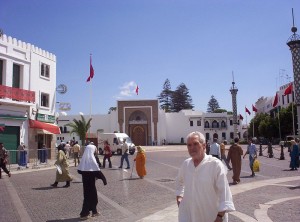As soon as we arrived in Tetuoan, I knew it was different than other Moroccan cities we had visited. But I couldn’t quite pinpoint what exactly cause the difference.
Since Tetuoan is located in the far North of Morocco, near the Spanish autonomous city of Ceuta, there is a lot of Spanish influence, which was one notable difference. Many of the residents spoke Spanish, but, many spoke Moroccan Arabic and French as well, making the city a very multilingual place. There is also Berber influence, from the South of Morocco, and in fact the name “Tetouan” directly translates to “The Eyes” in Berber. One day while having lunch in the restaurant of the Hotel Atenas, where the waitstaff spoke all three languages, I at one point said “un bouteille maa'”, before realizing it was a combination of Spanish, French, and Arabic. Communicating was confusing at times, but it was fascinating how much people can understand while speaking odd mixtures of languages they have in common.
Architecturally, the new part of the city seemed very French so I was curious as to what the medina was like, especially since it is listed as a UNESCO world heritage site. On our first night in Tetouan, I went into the Medina in the evening with Zha to search for a teapot. We did not have much of a plan, but entered the medina at the “bab” near the Royal Palace. We must have entered the produce market, because most of what we encountered was fruit, vegetables, and fish for sale. We eventually decided to head back to our hotel since it was getting later.
On Sunday, a group of us decided to go back into the medina for more shopping before we left Morocco for Ceuta. This time we entered through a different “bab.” While at first it seemed like we were again heading in the wrong direction, through muddy, winding alleyways, we eventually were stopped by a man sitting outside a shop. He asked us if we were interested in going to the artisan market and then led us in the right direction. Even though it was a Sunday and many shops were closed, the market was larger than I expected. While walking around with Sarah, one shopkeeper asked us if we wanted to see his rug shop. Of course, he was trying to sell us a rug, which I was interested in, but I’m glad we went in his shop, because he brought us to the roof and showed us an amazing view of the city. He also had a family member of his bring us the to the “Spice House” that his family owns, which sold many oils and herbal remedies. Later, a different shopkeeper brought us on a personal tour of the tanneries and then brought us to an artisan’s co-op, which had the most amazing selection of rugs that I had ever seen, which is a feat for Morocco, where incredible rugs are crammed into shops hidden in the tiniest of alleyways. While I realize that much of this personal attention occurred because it was a slow Sunday and these merchants were trying to make sales, I still appreciated it. I was able to get an impromptu tour of this fascinating Medina by the people who know it best: those that work there everyday.

